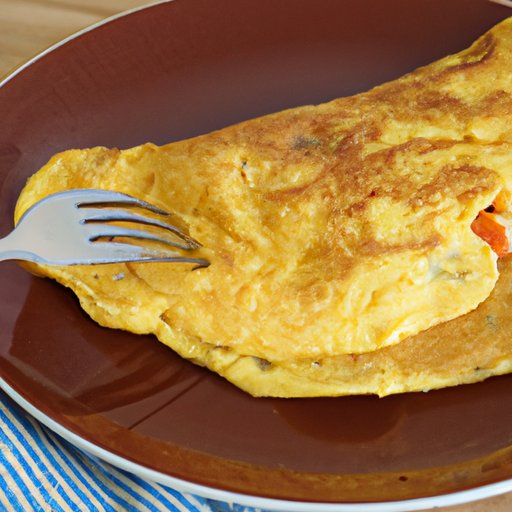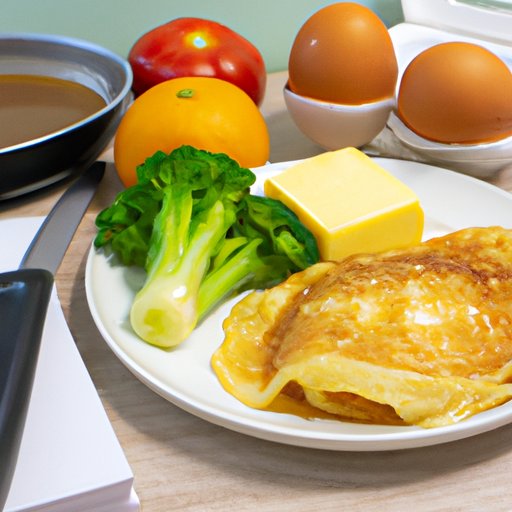
Introduction
Making a perfect omelet is not an easy feat. The process can be daunting for new cooks or those who are intimidated by the cracking of eggs and flipping a pan. But with a little bit of guidance, anyone can master this classic dish and impress their friends and family. This article will provide a step-by-step guide on how to make a perfect omelet, different types of omelets to try at home, tips for choosing the right pan and ingredients, ways to customize your omelet, how to fill and fold an omelet properly, and common mistakes to avoid.
A Step-by-Step Guide to Making the Perfect Omelet
Preparation
Before you start making your omelet, ensure you have the necessary ingredients and equipment. For one omelet, you will need:
- 2-3 eggs
- Salt and pepper
- Butter or oil
- Fillings (optional)
- A non-stick or well-seasoned frying pan
- A spatula
Step 1: Whisking the Eggs
Crack the eggs in a bowl and whisk them until the yolks and whites are combined. Add salt and pepper to taste and continue whisking until the mixture is smooth and frothy.
Step 2: Cooking the Eggs
Heat the pan on medium-high heat and add the butter or oil. Once the butter is melted or the oil is hot, pour the egg mixture into the pan. Use a spatula to gently move the eggs around, scraping the edges of the pan. When the eggs begin to set, lower the heat and let the omelet cook for about 1-2 minutes.
Step 3: Adding the Fillings
If you are adding fillings, now is the time to do so. Place the fillings on one half of the omelet. If you’re using cheese, add it last so that it melts on top of the other fillings.
Step 4: Folding the Omelet
Using the spatula, lift the unfilled side of the omelet and fold it over the fillings. Let it cook for another minute or until the cheese is melted. If the omelet is a little runny, you can flip the omelet and cook for a few more seconds.
Step 5: Finishing Touches
Carefully slide the omelet onto a plate then garnish with herbs or sprinkle a little cheese. Serve hot and enjoy your delicious, perfectly cooked omelet!
Different Types of Omelets You Can Try Making at Home
Omelets are very versatile, and there are many variations to choose from. Here are a few ideas to get you started:
Western Omelet
A western omelet is filled with ham, green peppers, onions, and cheese.
Spanish Omelet
A Spanish omelet has potatoes, onions, and chorizo sausage.
Mushroom Omelet
A mushroom omelet is filled with sautéed mushrooms, onions, and cheese.
Tips for Choosing the Right Pan and Ingredients
The right pan and ingredients can make all the difference when it comes to making a perfect omelet.
The Best Pan to Use for Making an Omelet
Use a non-stick frying pan or a well-seasoned cast-iron pan. A 8-10 inch pan is ideal for making a single omelet. The surface of the pan must be smooth and free of scratches; otherwise, the eggs will stick.
Tips for Choosing Eggs and Add-ins
Use fresh eggs, preferably organic, and avoid those that have cracks on their shells. When it comes to fillings, experiment with different combinations of flavors, textures, and colors. Try using leftover vegetables, herbs, and cheeses from your fridge. But don’t overfill your omelet, or it will be difficult to fold and will likely stick to the pan.
Ways to Customize Your Omelet to Your Taste
Now is your chance to add some flair to your omelet! Some popular ingredient combinations are:
Spinach and Feta
Add some cooked spinach and crumbled feta cheese to your egg mixture.
Ham and Cheese
Add some shredded ham and cheese for a classic omelet filling.
Jalapeno and Tomato
Add sliced jalapeno peppers and diced tomatoes to your egg mixture to give it a zesty kick.
How to Fill an Omelet and Fold It Properly
How to Put Fillings in an Omelet Without Overfilling
When adding fillings, be careful not to overfill the omelet. For a single omelet, use no more than 1/3 cup fillings. Too much filling will make it hard to fold the omelet.
How to Fold the Omelet Properly
Use a spatula to carefully lift one side of the omelet and fold it over the filling. Gently press the omelet down to ensure it’s sealed. Tilt the pan over your plate and let the omelet slide onto it. A perfectly folded omelet will have a golden brown exterior and a soft, fluffy center.
Common Mistakes to Avoid When Making an Omelet
Here are some common mistakes that beginners often make and how to avoid them:
- Overcooking the eggs: Cook the eggs until they are just set and still slightly runny. Overcooked eggs will be tough and chewy.
- Not using enough butter or oil: The eggs will stick to the pan if you don’t use enough butter or oil. Use a non-stick pan or a well-seasoned cast-iron pan and make sure it’s hot before adding the eggs.
- Overfilling the omelet: Too much filling will make it difficult to fold the omelet properly. Use no more than 1/3 cup of filling for a single omelet.
- Not seasoning the eggs: Salt and pepper will enhance the flavor of your omelet. Be sure to add them to the egg mixture before cooking.

Serving Suggestions and Ideas for Pairing Your Omelet with Other Dishes
Omelets are a great dish on their own, but they can also be paired with other foods. Here are some suggestions for complementary side dishes:
- Toasted bread or bagel
- Fruit salad or berries
- Hash browns or roasted potatoes
- Bacon or sausage
- Coffee or tea
Conclusion
Cooking an omelet can seem like a daunting task, but it’s easier than it looks. By following this step-by-step guide, you’ll be able to make the perfect omelet every time. Remember to experiment with different fillings and seasoning to find the flavor combinations that suit your taste buds. Omelets are an excellent breakfast, brunch, or even dinner option, and it’s a great way to use up any vegetables and eggs you have in your fridge.





